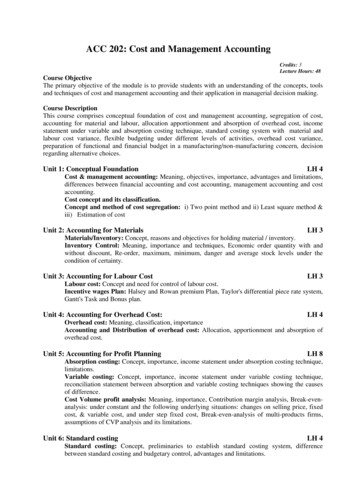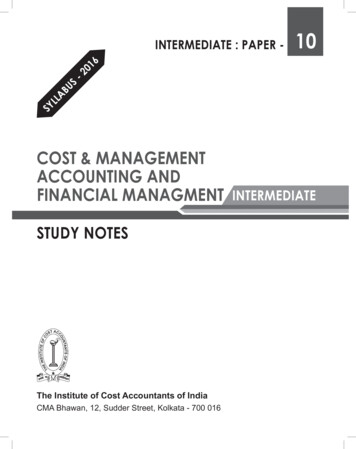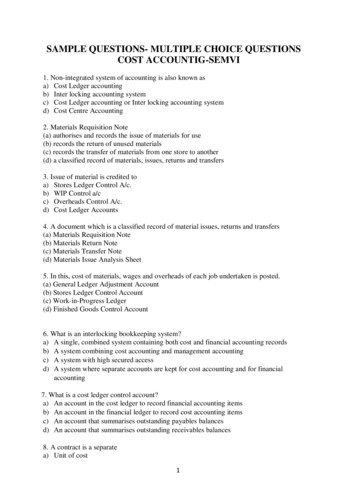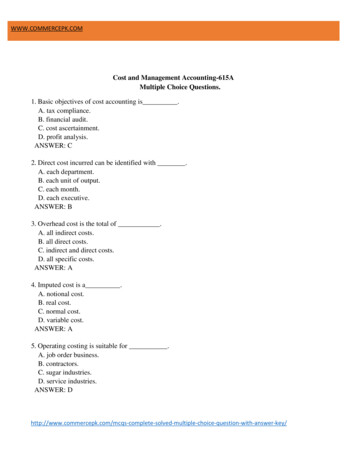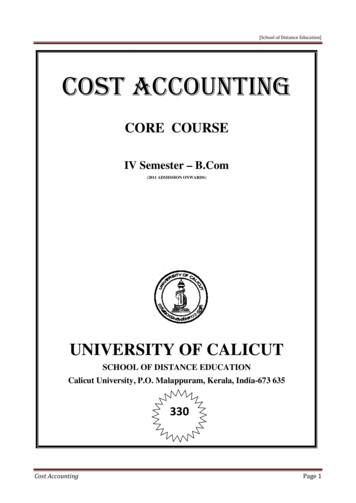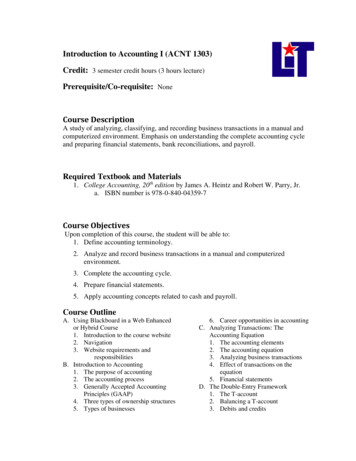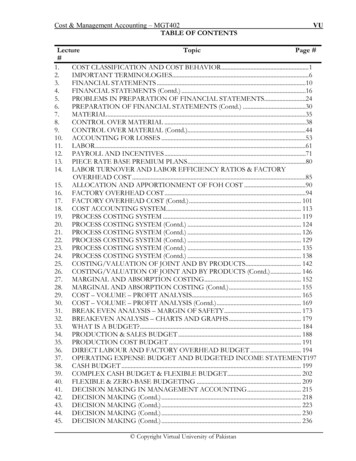
Transcription
Cost & Management Accounting – MGT402TABLE OF CONTENTSVULectureTopicPage ##1.COST CLASSIFICATION AND COST BEHAVIOR .12.IMPORTANT TERMINOLOGIES.63.FINANCIAL STATEMENTS .104.FINANCIAL STATEMENTS (Contd.) .165.PROBLEMS IN PREPARATION OF FINANCIAL STATEMENTS.246.PREPARATION OF FINANCIAL STATEMENTS (Contd.) .307.MATERIAL .358.CONTROL OVER MATERIAL .389.CONTROL OVER MATERIAL (Contd.).4410. ACCOUNTING FOR LOSSES .5311. LABOR .6112. PAYROLL AND INCENTIVES .7113. PIECE RATE BASE PREMIUM PLANS .8014. LABOR TURNOVER AND LABOR EFFICIENCY RATIOS & FACTORYOVERHEAD COST .8515. ALLOCATION AND APPORTIONMENT OF FOH COST .9016. FACTORY OVERHEAD COST .9417. FACTORY OVERHEAD COST (Contd.) . 10118. COST ACCOUNTING SYSTEM. 11319. PROCESS COSTING SYSTEM . 11920. PROCESS COSTING SYSTEM (Contd.) . 12421. PROCESS COSTING SYSTEM (Contd.) . 12622. PROCESS COSTING SYSTEM (Contd.) . 12923. PROCESS COSTING SYSTEM (Contd.) . 13524. PROCESS COSTING SYSTEM (Contd.) . 13825. COSTING/VALUATION OF JOINT AND BY PRODUCTS . 14226. COSTING/VALUATION OF JOINT AND BY PRODUCTS (Contd.) . 14627. MARGINAL AND ABSORPTION COSTING . 15228. MARGINAL AND ABSORPTION COSTING (Contd.) . 15529. COST – VOLUME – PROFIT ANALYSIS . 16530. COST – VOLUME – PROFIT ANALYSIS (Contd.) . 16931. BREAK EVEN ANALYSIS – MARGIN OF SAFETY . 17332. BREAKEVEN ANALYSIS – CHARTS AND GRAPHS . 17933. WHAT IS A BUDGET?. 18434. PRODUCTION & SALES BUDGET . 18835. PRODUCTION COST BUDGET . 19136. DIRECT LABOUR AND FACTORY OVERHEAD BUDGET . 19437. OPERATING EXPENSE BUDGET AND BUDGETED INCOME STATEMENT19738. CASH BUDGET . 19939. COMPLEX CASH BUDGET & FLEXIBLE BUDGET . 20240. FLEXIBLE & ZERO-BASE BUDGETING . 20941. DECISION MAKING IN MANAGEMENT ACCOUNTING . 21542. DECISION MAKING (Contd.) . 21843. DECISION MAKING (Contd.) . 22344. DECISION MAKING (Contd.) . 23045. DECISION MAKING (Contd.) . 236 Copyright Virtual University of Pakistan
Cost & Management Accounting–MGT402VULESSON 01COST CLASSIFICATION AND COST BEHAVIORINTRODUCTIONCost AccountingCost Accounting is an expanded phase of financial accounting which provides managementpromptly with the cost of producing and/or selling each product and rendering a particular service.Management AccountingManagement accounting is application of professional knowledge and skill in the preparation andpresentation of financial information in such a way as to assist management in decision making andin the planning and control of operations of the entity.ObjectivesObjective of cost accounting is computation of cost per unit, whereas the objective of managementaccounting is to provide information to the management for decision making purposes.Users of Cost AccountingUsers of cost & management accounting are the decision makers and the managers of theentity/organization for which all this exercise is undertaken.Uses of Cost and Management Accounting1. It determines total cost of production and cost of sales2. It determines appropriate selling price3. It discloses the profitable products, areas and activity/capacity levels4. It is used to decide whether to manufacture or purchase from outside5. It helps in planning and controlling the cost of productionElements of CostAny product that is manufactured is the result of consumption of some resources. Themanagement, for its planning and controlling functions, must know the cost of using theseresources. The constituent elements of cost are broadly classified into three distinct elements:1 Direct Material Cost2 Direct Labor Cost3 Other Production Costa)Direct Costb) Indirect CostCOST CLASSIFICATIONElements of cost (Direct Material, Direct Labor, Other Production costs) can be classified as directcost or indirect cost.Direct CostA direct cost is a cost that can be traced in full to the product or service for which cost is beingdetermined. Direct cost can be economically identified with a specific saleable product or service(cost unit).a) Direct material costs are the costs of materials that are known to have been used in producingand selling a product or rendering a service.b) Direct labor costs are the specific costs of the workforce used to produce a product orrendering a service. Copyright Virtual University of Pakistan1
Cost & Management Accounting–MGT402VUc) Other direct production costs are those expenses that have been incurred in full as a directconsequence of producing a product, or rendering a service.Indirect Cost/Overhead CostAn indirect cost or overhead cost is a cost that is incurred in the course of producing product orrendering service, but which cannot be traced in the product or service in full.Expenditure incurred on labor, material or other services which cannot be economically identifiedwith a specific cost product or service (cost unit).Examples include:Wages of supervisor, cleaning material and workshop insurance ectIndirectTotalPrime CostFactory1. Prime CostDirect Material Direct Labor Other direct production costPrime cost.2. Total Production CostPrime Cost Factory overhead costTotal production cost.3. Conversion CostDirect labor cost Factory overhead costConversion cost.COST BEHAVIORCost behavior is the way in which total production cost is affected by fluctuations in the activity(production) level.Activity levelThe activity level refers to the amount of work done, or the number of events that have occurred.Depending on circumstances, the level of activity may refer to the volume of production in aperiod, the number of items sold, the value of items sold, the number of invoices issued, thenumber of invoices received, the number or units of electricity consumed, the labor turnover etc.Basic principleThe basic principle of cost behavior is that as the level of activity rises, costs will usually rise. Forexample; it will cost more to produce 500 units of output than it will cost to produce 100 units; itwill usually cost more to travel 10 km than to travel 2 km. Although the principle is based on thecommon sense, but the cost accountant has to determine, for each cost elements, whether whichcost rises by how much by the change in activity level.Division of cost by its behaviorBasically, the cost of production has two behaviors:1. Fixed Cost2. Variable Cost Copyright Virtual University of Pakistan2
Cost & Management Accounting–MGT402Fixed CostIt is a cost which tends to be constant by increase or decrease in the activity level.VUThis graph shows that the cost remains fixed regardless of the volume of output. Examplesinclude:a. Salary of the production manager (monthly/annual)b. Insurance premium of factory work shopc. Depreciation on straight line methodVariable CostA variable cost is a cost which tends to vary directly with the change in activity level. The variablecost per unit is the same amount for each unit produced whereas total variable cost increases asvolume of output increases.This graph shows a proportionate increase in the cost by the increase in the activity level.Examples include:a. Cost of raw-material consumedb. Direct labor costc. Selling commissionFurther division of cost behavior1. Step fixed cost2. Semi variable cost Copyright Virtual University of Pakistan3
Cost & Management Accounting–MGT402VUStep Fixed CostA step fixed cost is the cost which is constant for a specific range of activity and rises to a newconstant level once the range exceeds. The range over which the fixed cost remains constant isknown as the relevant range.For example; the depreciation of a machine may be fixed if production remains below 100 numberof units per month, but if the production exceeds 100 number of units, a second machine maynow be required, and the cost of depreciation would go up a step. Other examples include:a. Rent of workshop (in case of increase in the production one needs to rent one moreworkshop)b. Salary of supervisor (increase in output will be supervised by increased number ofsupervisors)This graph shows a stepwise increase in the total cost. Relevant range in this graph is of 100numbers of units.Semi Variable CostIt is also known as mixed cost. It is the cost which is partially fixed and partially variable. It is infact the mixture of both behaviors.Examples include: Utility bills – there is a fixed line rent plus charges for units consumed.Salesman’s salary – there is a fixed monthly salary plus commission per units sold. Copyright Virtual University of Pakistan4
Cost & Management Accounting–MGT402This graph shows a fixed cost of Rs. 2,000 and thereafter the cost is variable.VUCOST BEHAVIOR PER UNIT OF PRODUCTIONCost Behavior per unit of productionCost per unit behaves differently than the total cost of production. Following tables show thedifference in behavior.Increasing Production Volume ing Production Volume SituationFixedVariableTotalIncrease or decrease in production volume causes no change to the variable cost per unit it remainsconstant, assuming there is no rebate in case of bulk purchase and the labor receives constant ratedespite change in production volume.Whereas, increase in production volume causes a decrease in fixed cost per unit and in the sameway a decrease in production volume causes an increase in fixed cost per unit.Following example helps in understanding this concept.Total fixed cost Rs. 4,000Per unit variable cost Rs. 3Cost per unit at different activity levels 1000, 2000, 4000, and 5000 units Copyright Virtual University of Pakistan5
Cost & Management Accounting–MGT402VULESSON 02IMPORTANT TERMINOLOGIESCost UnitIt is a unit of a product or service in relation to which the cost is ascertained, i.e. it is the unit of theoutput or product of the business. In simple words, the unit for which cost of producing the unitsis identified /allocated.ExamplesBall point for a Ball point manufacturing entityBottle for Beverage producing entityFan for a Fan manufacturing entityCost CenterCost centre is a location where costs are incurred and may or may not be attributed to cost units.ExamplesWorkshop in a manufacturing concernAuto service departmentElectrical service departmentPackaging departmentJanitorial service departmentRevenue CentreIt is part of the entity that earns sales revenue. Its manager is responsible for the revenue earnednot for the cost of operations.ExamplesSales departmentFactory outletProfit CentreProfit centre is a section of an organization that is responsible for producing profit.ExamplesA branchA divisionInvestment CentreAn investment centre is a segment or a profit centre where the manager has significant degree ofcontrol over his/her division’s investment policies.ExamplesA branchA divisionRelevant CostRelevant cost is which changes with a change in decision. These are future costs that effect thecurrent management decision.ExamplesVariable costFixed cost which changes with in an alternativesOpportunity costIrrelevant CostIrrelevant costs are those costs that would not affect the current management decision.Example Copyright Virtual University of Pakistan6
Cost & Management Accounting–MGT402A building purchased in last year, its cost is irrelevant to affect management decisions.VUSunk CostSunk cost is the cost expended in the past that cannot be retrieved on product or service.ExampleThe entity purchase stationary in bulk last month. This expense has been incurred and hencewill not be relevant to the management decisions to be taken subsequent to the purchase.Opportunity CostOpportunity cost is the value of a benefit sacrificed in favor of an alternative.ExampleAn investor invests in stock exchange he foregoes the opportunity to invest further in hishotel. The profit which the investor will be getting from the hotel is opportunity cost.Product CostProduct cost is a cost that is incurred in producing goods and services. This cost becomes part ofinventory.ExampleDirect material, direct labor and factory overhead.Period CostThe cost is not related to production and is matched against on a time period basis. This cost isconsidered to be expired during the accounting period and is charged to the profit & loss account.ExampleSelling and administrative expensesHistorical CostIt is the cost which is incurred at the time of entering into the transaction. This cost is verifiablethrough invoices/agreements. Historical cost is an actual cost that is borne at the time of purchase.ExampleA building purchased for Rs. 400,000 has market value of Rs. 1,000,000. Its historical cost isRs. 400,000.Standard CostStandard cost is a predetermine cost of the units.ExampleStandard cost for a unit of product ‘A’ is set at Rs.30. It is compared with actual cost incurredfor control purposes.Implicit CostImplicit cost imposed on a firm includes cost when it foregoes an alternative action but doesn'tmake a physical payment. Such costs are related to forgone benefits of any single transaction, andoccur when a firm:ExampleUses its own capital orUses its owner's time and/or financial resourcesExplicit CostExplicit cost is the cost that is subject to actual payment or will be paid for in future.ExampleWageRentMaterials Copyright Virtual University of Pakistan7
Cost & Management Accounting–MGT402Differential Cost or Incremental costIt is the difference of the costs of two or more alternatives.ExampleDifference between costs of raw material of two categories or quality.VUCosting:The measurement of cost of a product or service is called costing; however, it is not arecommended terminology.Cost Accounting:It is the establishment of budgets, standard cost and actual costs of operations, processes, activitiesor products and the analysis of variances, profitability or social use of funds. It involves a carefulevaluation of the resources used within the business. The techniques employed are designed toprovide financial information about the performance of a business and possibly the directionwhich future operations should take.Prime Cost:The total costs which can be directly identified with a job, a product or service is known as Primecost. Thus, prime cost direct materials direct labor other direct expenses.Conversion Cost.This is the total cost of converting the raw materials into finished products. The total of directlabor, other direct expenses and factory overhead cost is known as conversion costCost AccumulationCost accumulations are the various ways in which the entries in a set of cost accounts (costsincurred) may be aggregated to provide different perspectives on the information.Methods of cost accumulationProcess costingIt is a method of cost accounting applied to production carried out by a series of operationalstages or processes.Job order costingGenerally, it is the allocation of all time, material and expenses to an individual project or job.Assignment QuestionsAnswer to each of the following question should not exceed five lines.1. Define Cost Accounting2. What are the three broad elements of cost?3. Give any five examples of factory overhead cost. Also explain.4. Give any two examples of distribution overheads.5. Give any two examples of office overheads6. Define direct cost and give two examples.7. What is indirect cost? Give three examples.8. What is meant by step fixed cost and semi-variable cost? Also show graphs.9. What is fixed cost? Give three items of fixed cost, also show its graph. Copyright Virtual University of Pakistan8
Cost & Management Accounting–MGT402Exam Type Questions1.2.3.4.5.6.VUWhat is a cost unit? Give two examples.Define cost centre. How does it differ from cost unit?What is the difference between direct and indirect materials? Give two examples of each.Fixed cost per unit remains fixed. Do you agree?How variable cost per unit behaves? Give two examples.What are semi-variable costs? Draw graph for such costs.Multiple Choice QuestionsChoose the correct answer in each of the following MCQ.1. The main purpose of cost accounting is toa. Maximize profitsb. Help in inventory valuationc. Provide information to management for decision makingd. Aid in the fixation of selling price2. Fixed cost per unit increases whena. Variable cost per unit increasesb. Variable cost per unit decreasesc. Production volume increasesd. Production volume decreases3. Variable cost per unita. Varies when output variesb. Remains constantc. Increases when output increasesd. Decreases when output decreases4. Which of the followings is the reason of increase in total variable cost?a. Increase in fixed costb. Rise in interest on capitalc. Increase in direct material costd. Depreciation of machinery5. Which of the followings is an example of fixed cost?a. Direct material costb. Works manager’s salaryc. Depreciation of machineryd. Chargeable expenses6. Cost accounting concepts include all of the following except:a. Planningb. Controllingc. Sharingd. Costing7. The three elements of product cost are all buta. Direct material costb. Factory overhead costc. Indirect labor costd. Direct labor costAnswers:Q1Q2Q3Q4Q5Q6Q7cdbcccc Copyright Virtual University of Pakistan9
Cost & Management Accounting–MGT402FINANCIAL STATEMENTSVULESSON 03Purpose of preparing financial statementsFinancial statements are prepared to demonstrate financial results to the users of financialinformation. These are the reports, which are prepared by the accounting department and are usedby different people inclusive of the management.According to IASB framework:“Financial statements exhibit its users the financial position, financial performance, and cashinflow and outflow analysis of an entity.”Components of Financial StatementsAccording to IASB framework, there are five components of financial statements:Balance Sheet:Income Statement:Statement of changes in Equity:Cash Flows Statement:Notes (to the accounts):Statement of financial position at a given point in time.Income minus expenses for a given time period ending at aspecified date.Also known as Statement of Retained Earnings or EquityStatement.Summarizes inflows and outflows of cash and cashequivalents for a given time period ending at a specifieddate.Includes accounting policies, disclosures and otherexplanatory information.It is not possible for all the business entities to prepare all of the components of the financialstatements, it depends upon the size, nature and statutory requirements of each of the entities thatwhether all components are to be prepared or not.For example, a small business entity (like a washer man) does not need to prepare statement ofchanges in equity or notes to the accounts as the size of information is very little and not complex.Financial statements prepared by the Cost AccountantCost accounting department prepares reports that help the accounting department in preparingfinal accounts, these include: Cost of goods manufactured statement Cost of goods sold statementBoth of the statements represent production cost function or the function of expenses that areincurred to make the goods or services available for sale. It depends upon the form of the businessentity whether what should be disclosed in these statements and what should be the extent of thedetails to be given into these statements.Forms of business entitiesManufacturing EntitiesManufacturing entities purchase materials and components and convert them into finished goods.Costing department of these entities works very much efficiently, a complete cost accountingsystem is followed in manufacturing concerns in which procedures of cost accumulation, methodsof product costing, process of calculating per unit cost and determining the cost of inventories aredefined. Copyright Virtual University of Pakistan10
Cost & Management Accounting–MGT402VUTrading EntitiesTrading entities purchase and then sell tangible products without changing their basic form.Costing department of these entities is not involved in that much minute calculations andprocedures.It simply has to keep records of the cost of goods purchased and cost of inventory.Servicing EntitiesServicing entities provide services or intangible products to their customers.Costing department of these entities is also concerned with calculation of the cost of serviceprovided. Inventory of service is also determined in this type of concerns.InventoryIt is the cost held in material & supplies, work in process and finished goods that will provideeconomic benefits in future, it is also known as stock.Adjustment for inventories is pivotal in calculation of cost of goods sold. The basic reason for itsadjustment is that profit and loss account is prepared on the basis of accrual concept. Adjustmentsof opening and closing inventories in the cost of production (for manufacturing entities), cost ofpurchases (for trading entities) is essential to match the cost with its revenue.For manufacturing entities inventories are classified into three categories:1. Material and supplies inventory2. Work in process inventory3. Finished goods inventoryFollowing is a self-explanatory chart for different categories of inventories. Copyright Virtual University of Pakistan11
Cost & Management Accounting–MGT402Standard format of the cost of goods sold statement:VU(Important tip for students)To prepare cost of goods sold statement, firstly one needs to collect six elements. Three of thesebelong to the cost and three belong to the inventory. Copyright Virtual University of Pakistan12
Cost & Management Accounting–MGT402VUPRACTICE QUESTIONSQ. 1Following data relates to Zain & Co:RupeesOpening stock of raw material80,000Opening stock of work in process51,000Purchases of raw material230,000Direct labor cost94,000Factory overheads79,000Closing stock of raw material66,000Closing stock of work in process44,000Required:1) Prime cost2) Total Factory costSOLUTION:1) Prime cost:Opening stock of raw materialAdd: Purchases of raw materialLess: Closing stock of raw materialCost of raw material consumedAdd: Direct labor costPrime cost/Direct 02) Total Factory Cost:Prime costAdd: Factory overheadsTotal Manufacturing cost/Factory cost338,00079,000417,000Q. 2Usama manufacturing company submits the following information on June 30, 2005:Raw material inventory, July 1, 2004PurchasesPower, heat and light25,000125,0003,500 Copyright Virtual University of Pakistan13
Cost & Management Accounting–MGT402Indirect material purchased and consumedAdministrative expensesDepreciation of plantPurchases returnsFuel expensesDepreciation of buildingCarriage inwardsBad debtsIndirect laborOther manufacturing expensesRaw materials inventory, June 30,2005Required:1) Cost of raw material consumed.2) Factory overhead costSOLUTION:1) Cost of raw material consumed:Raw materials inventory, July 1 2004Add: purchases of materialsLess: purchase returnsAdd: carriage inwardsLess: materials inventory, June 30, 2005Cost of materials consumed2) Factory overhead cost:Power, heat and lightIndirect material purchased and consumedDepreciation of plantIndirect laborFuel expensesOther manufacturing expensesTotal Factory 00Q. 3:Following data relates to Qasim & Co,Opening stock of raw material52,000Opening stock of work in process46,000Purchases of raw material255,000Direct labor cost85,000Factory overheads76,000Closing stock of raw material61,000Closing stock of work in process36,000Required: Prepare a statement showing total manufacturing cost.SOLUTION:Qasim & Co.Cost of goods manufactured statementOpening stock of raw material52,000Add: Purchases of raw material255,000Less: Closing stock of raw material(61,000)Cost of raw material consumed246,000 Copyright Virtual University of Pakistan14
Cost & Management Accounting–MGT402Add: Direct labor costPrime cost/Direct costAdd: Factory overheadsManufacturing cost/Factory costVU85,000331,00076,000407,000Q. 4FNS manufacturing company submits the following information on June 30, 2005.Sales for the yearRaw material inventory, July 1, 2004Finished goods inventory, July 1, 2004PurchasesDirect laborPower, heat and lightIndirect material purchased and consumedAdministrative expensesDepreciation of plantSelling expensesDepreciation of buildingBad debtsIndirect laborOther manufacturing expensesWork in process, July 1, 2004Work in process, June 30, 2005Raw materials inventory, June 30, 2005Finished goods inventory, June 30, 00060,000Required:1) Calculate cost of raw-material consumed2) Calculate prime cost3) Calculate total factory costSOLUTION:FNS manufacturing companyCost of goods manufactured statementFor the year ended June 30, 2005Raw materials inventory, July 1 2004Add: purchases of materialsLess: materials inventory, June 30,2005Cost of materials consumedAdd: direct laborPrime cost/Direct costFactory overheads:Power, heat and lightIndirect material purchased and consumedDepreciation of plantIndirect labor 3,000Other manufacturing expensesTotal Manufacturing cost/Factory 4,50014,00010,00034,000213,000 Copyright Virtual University of Pakistan15
Cost & Management Accounting–MGT402VUFINANCIAL STATEMENTS (Contd.)LESSON 04Cost of Goods Sold Statement:Six basic ElementsCostInventoriesMaterial & SuppliesMaterial & SuppliesLaborWork in processFOHFinish goodsCost of Goods Manufactured RupeesTotal factory CostAdd Opening Work in process inventoryCost of goods to be manufacturedLess Closing Work in processCost of goods manufactured230,00030,000260,00050,000210,000Note: Cost of the work that was in process in the last year (Closing WIP inventory) becomes Opening WIPinventory of the current year.Cost of Goods SoldCost of goods manufacturedAdd Opening finished goods inventoryCost of goods to be soldLess Closing finished goodsCost of goods sold210,000100,000310,000(10,000)300,000Note: Cost of the goods that were in process in the last year (closing finished goods inventory) becomes openingfinished goods inventory of the current year.Standard format of the cost of goods manufactured and sold statement:Entity NameCost of Goods manufactured statementfor the year endedRupeesDirect Material ConsumedOpening inventory10,000Add Net Purchases100,000Material available for use110,000Less Closing inventory(20,000)Direct Material used90,000Add Direct labor60,000Prime cost150,000Add Factory overhead Cost80,000Total factory cost230,000Add Opening Work in process30,000Cost of good to be manufactured260,000Less Closing Work in process50,000Cost of goods manufactured210,000 Copyright Virtual University
Cost Accounting is an expanded phase of financial accounting which provides management promptly with the cost of producing and/or selling each product and rendering a particular service. Management Accounting Management accounting is application of professional knowledge and skill in the preparation and


